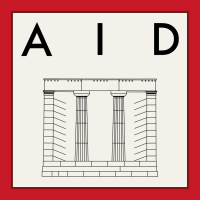Attic Inscriptions in Delphi (AID)

Project background and goals
In ancient times, Athens was Greece's largest and most powerful polis and the sanctuary of Apollo Pythios at Delphi was one of its most significant Panhellenic cult sites. Therefore, there was great pressure from the Athenians to be visible at the site of the famous oracle. Our most important sources for the Athenian presence at Delphi and the relationship between Athens and Delphi are literary texts, archaeological remains, and, above all, ancient Greek inscriptions. This is a rich vein of source material, but, despite its great historical relevance, some researchers find it daunting. The need for specialist epigraphic knowledge and the inaccessibility of epigraphic corpora can make this material difficult for students and less experienced scholars from other sub-disciplines of Classical Studies to work with. As a result, key sources can be neglected, to the detriment of scholarship.
The Attic Inscriptions in Delphi (AID) project has three goals. Firstly, we seek to make the relevant ancient Greek inscriptions accessible to a broad international readership through a digital publication of English translations and commentaries, explaining the contents of the inscriptions, addressing key points of the texts and inscribed objects, and placing them in their broader epigraphic and historical contexts. To ensure high visibility and easy access to this material, these translations and commentaries are being published on Attic Inscriptions Online (AIO), an open access website that has become one of the central resources for Attic epigraphy since its establishment in 2012, in collaboration with Prof. Stephen D. Lambert (Universities of Cardiff and Edinburgh, UK) and Dr. Christopher de Lisle (Durham University, UK). The individual AID entries follow AIO's established norms for editions and publications. To ensure the academic quality of the published material, each entry is reviewed individually by the AIO Advisory Board before publication. This body is composed of internationally recognised scholars, including the project leader, Prof. Dr. Kai Trampedach of the Department of Ancient History and Epigraphy at Heidelberg.
Secondly, beyond this important foundational work, we seek to contribute to further research on the relevant inscriptions and to investigate the relationship between Athens and Delphi from an epigraphic perspective. For the reasons mentioned above, this has been undertaken up till now only in the context of individual inscriptions or in very brief discussions. By contrast, we will analyse all the material in a comprehensive study, taking account of inscriptions that have hitherto received little or no attention. The results of this work shall be published online as two long-form articles in the AIO Papers series. These papers are peer-reviewed, open access, and addressed to an international readership.
Thirdly, through this project, we aim to introduce talented young scholars to work in the space between research and knowledge transfer in the area of Digital Humanities. The students will work independently on sets of related inscriptions according to the aforementioned principles and prepare them for publication in their own names on the AIO website. Moreover, they shall contribute to the final publication as an AIO Paper. They will be supported in this through workshops, in which the work shall be critically discussed by the whole team under the leadership of Prof. Dr. Kai Trampedach, and through feedback from the AIO Advisory Board.
Results to date and next steps
Out of a total of 41 relevant inscriptions, we have published 30 representative examples on the AIO website. Entries include links to the ancient Greek original texts of the inscriptions, where these are available online through the PHI database and IG Online. In cases where no up-to-date edition is available online, we have provided one. The AIO Papers will follow after the peer review process, expected in late 2024. While only inscriptions which were published in Delphi by the Athenian polis or individual Athenian citizens will receive entries on the AIO website, the AIO Paper will also include other inscriptions that are important for evaluating the relationship between Athens and Delphi (e.g., honorific decrees of the Delphians for Athenian citizens and inscriptions relevant to Delphi from Athens itself).
Inscriptions already translated and published: Set 1 and Set 2
Project Leaders
Niklas Bettermann (Heidelberg) | Christopher de Lisle (Durham) | Nicolai Futás (Heidelberg) | Kai Trampedach (Heidelberg) | Banban Wang (Heidelberg)
Team members
Caroline Albert | Giacomo Aresi | Niklas Bettermann | Christopher de Lisle | Hannes Freitag | Nicolai Futás | Tobias Hirsch | Dustin Hoferichter | Claudio Huayna | Riccarda Knauß | Feng Liu | Julia Ortseifen | Jonas Osnabrügge | Kai Trampedach | Banban Wang | Sebastian Zellner

